| Last night we showed you the end result of the sculpture symposium - 9 monumental sculptures which are currently on display at the compound of the former Center For Employment Training.
Well, more than a few folks asked us what they are - or are supposed to represent.
A fair question, and we put it to the project organizer, Jock Hildebrand today:..
Jacques Hildebrand
"The pieces from the international artists are all really very contemporary modern approaches to sculpture."
Caroline Ramesdorfer, Austria
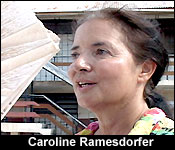
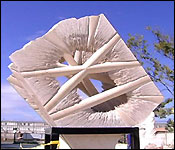
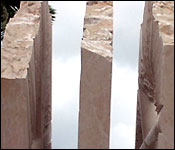 "A nexus point is a point of unity in time and space. The in-between spaces are important between one slab and the other and its unification of sad intellect feelings."
"A nexus point is a point of unity in time and space. The in-between spaces are important between one slab and the other and its unification of sad intellect feelings."
Jacques Hildebrand
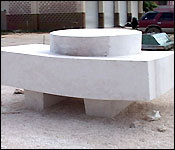
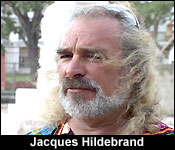 "The one behind here, there was some difficulty with the stone. A piece of the stone broke, so he had to redesign half way through with the stone. I think he calls it Belize Wave."
"The one behind here, there was some difficulty with the stone. A piece of the stone broke, so he had to redesign half way through with the stone. I think he calls it Belize Wave."
"The one behind is called Smoking Mirror by Colin from Britain. His idea came after he found the stone on the site and after he had been on a trip to Lamanai. When he was in Lamanai he came to understand about "Smoking Mirror" so he tried to use some of the Mayan sculpture influences that were there and try to turn it into a very contemporary redesign of some of their ideas."
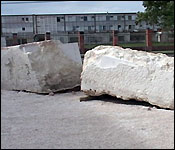 "Past that is Pictury, he is from Bulgaria. His piece is again a very contemporary piece, it's about the relationship between objects and the two stones, very specific about how he placed the stones and how the shapes inside the stone approach each other. So that's his approach."
"Past that is Pictury, he is from Bulgaria. His piece is again a very contemporary piece, it's about the relationship between objects and the two stones, very specific about how he placed the stones and how the shapes inside the stone approach each other. So that's his approach."
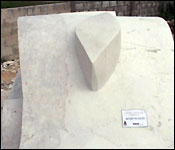 "On the far end is Roland from Germany. His piece is very tall, its two pieces and his interpretation - I am not exactly sure of because he didn't tell me. So some guys don't like to really talk about it, so the idea is that you take a look at it and you make your own consideration about it."
"On the far end is Roland from Germany. His piece is very tall, its two pieces and his interpretation - I am not exactly sure of because he didn't tell me. So some guys don't like to really talk about it, so the idea is that you take a look at it and you make your own consideration about it."
"Then of course we have Curl the Belizean sculptor, worked on that piece in two weeks. First time he works on stone, so quite astonishing in that context."
"Anthony Vacarro did the piece which essentially an interpretation of Lamanai, again Anthony was the second Belizean sculptor on
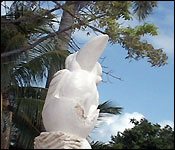
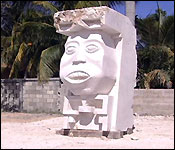 the project and over here we have Canan from Turkey. She incorporated a lot of the ancient sites from her country in this piece. A very flowing, almost watery feathery kind of interpretation, again this is something that people need to come and take a look at they can scratch their heads and say I know what that means and It could become what you and I say."
the project and over here we have Canan from Turkey. She incorporated a lot of the ancient sites from her country in this piece. A very flowing, almost watery feathery kind of interpretation, again this is something that people need to come and take a look at they can scratch their heads and say I know what that means and It could become what you and I say."
Jacques Hildebrand
"I think it's probably to date the major contribution to public art in Belize since the days of the Mayas. So there is a historical aspect that we can't really determine at this point but in terms of putting public art in public places, it's a major project."
Jules Vasquez
"As I understand it these pieces are being essentially donated by the artist."
Jacques Hildebrand
"Essentially that's right. The sculptors that you see working here, pieces this size would range from $50,000 - $100,000 US dollars. That's what they see for from here. So when I conceive the idea of the symposium we had to tell the sculptors that they would have the Belize experience and this is what would make it worthwhile and I think they would all agree that that's the case."
"In terms of how Belizeans would relate to this - unknown and I believe would be positive. How does it mean to the people the Belizean sculptors who are working here, one person said to me today a sculptor was born."
Caroline Ramesdorfer, Austria
"It's had been a challenge. It has been a wonderful collaboration despite the fact that it was a challenge. With the organizers and the assistance as well as the public who came here and cheered us up, It's a great honor to me to have this piece here in Belize and I hope that the public is going to enjoy it and I do hope it's going to have a nice place permanent installed and sure trust it will have."
Four of the pieces are currently designated for public spaces.
| 
